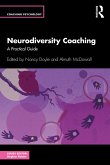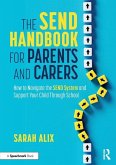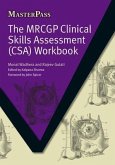- Broschiertes Buch
- Merkliste
- Auf die Merkliste
- Bewerten Bewerten
- Teilen
- Produkt teilen
- Produkterinnerung
- Produkterinnerung
This book provides guidance on recruiting, interviewing, and onboarding practices that will allow employers to successfully hire neurodivergent professionals into inclusive, competitive employment.
Andere Kunden interessierten sich auch für
![Neurodiversity Coaching Neurodiversity Coaching]() Nancy DoyleNeurodiversity Coaching44,99 €
Nancy DoyleNeurodiversity Coaching44,99 €![The Politics of Asian Americans The Politics of Asian Americans]() Pei-te LienThe Politics of Asian Americans254,99 €
Pei-te LienThe Politics of Asian Americans254,99 €![The SEND Handbook for Parents and Carers The SEND Handbook for Parents and Carers]() Sarah AlixThe SEND Handbook for Parents and Carers26,99 €
Sarah AlixThe SEND Handbook for Parents and Carers26,99 €![The Psychology of Chess The Psychology of Chess]() Fernand GobetThe Psychology of Chess22,99 €
Fernand GobetThe Psychology of Chess22,99 €![The MRCGP Clinical Skills Assessment (CSA) Workbook The MRCGP Clinical Skills Assessment (CSA) Workbook]() Monal WadheraThe MRCGP Clinical Skills Assessment (CSA) Workbook55,99 €
Monal WadheraThe MRCGP Clinical Skills Assessment (CSA) Workbook55,99 €![The AutPlay® Therapy Handbook The AutPlay® Therapy Handbook]() Robert Jason GrantThe AutPlay® Therapy Handbook52,99 €
Robert Jason GrantThe AutPlay® Therapy Handbook52,99 €![Neurodiverse Couple Therapy Neurodiverse Couple Therapy]() Kelli Murgado-WillardNeurodiverse Couple Therapy48,99 €
Kelli Murgado-WillardNeurodiverse Couple Therapy48,99 €-
-
-
This book provides guidance on recruiting, interviewing, and onboarding practices that will allow employers to successfully hire neurodivergent professionals into inclusive, competitive employment.
Hinweis: Dieser Artikel kann nur an eine deutsche Lieferadresse ausgeliefert werden.
Hinweis: Dieser Artikel kann nur an eine deutsche Lieferadresse ausgeliefert werden.
Produktdetails
- Produktdetails
- Verlag: Taylor & Francis Ltd
- Seitenzahl: 202
- Erscheinungstermin: 11. November 2021
- Englisch
- Abmessung: 229mm x 152mm x 11mm
- Gewicht: 300g
- ISBN-13: 9780367683887
- ISBN-10: 0367683881
- Artikelnr.: 62271556
- Herstellerkennzeichnung
- Books on Demand GmbH
- In de Tarpen 42
- 22848 Norderstedt
- info@bod.de
- 040 53433511
- Verlag: Taylor & Francis Ltd
- Seitenzahl: 202
- Erscheinungstermin: 11. November 2021
- Englisch
- Abmessung: 229mm x 152mm x 11mm
- Gewicht: 300g
- ISBN-13: 9780367683887
- ISBN-10: 0367683881
- Artikelnr.: 62271556
- Herstellerkennzeichnung
- Books on Demand GmbH
- In de Tarpen 42
- 22848 Norderstedt
- info@bod.de
- 040 53433511
Marcia Scheiner is the President and Founder of Integrate Autism Employment Advisors (Integrate), co-author of An Employer's Guide to Managing Professionals on the Autism Spectrum (2017), and frequent speaker on autism employment. Prior to founding Integrate in 2010, Ms. Scheiner held senior management positions in the financial services industry. Ms. Scheiner is a graduate of Wellesley College, Massachusetts and has an MBA from Columbia University's Graduate School of Business, New York. She is the parent of an adult son with autism. Tracy Powell-Rudy is a contributing author of this book. Joan Bogden is a Content and Media Training Coach and the President of Blonde 'n Blue Productions, as well as the co-author of An Employer's Guide to Managing Professionals on the Autism Spectrum (2017). She has over 30 years of experience in the communications and training industry and has a BA in psychology from Vassar College. Ms. Bogden received an MA in clinical psychology from Fordham University, where she was also a published researcher and a doctoral candidate in that field.
Acknowledgements
Introduction
How to Use This Book
PART 1: UNDERSTANDING THE ESSENTIALS
Chapter 1 - What Should I Know to Get Started?
The Myth of the "Normal" Brain
Neurodiversity 101
The Language of Neurodiversity
The Language of Autism
Disclosure
Chapter 2 - Why Hire Autistic Professionals?
Business Benefits
Economic Benefits
Societal Benefits
Chapter 3 - Are Neurodiversity Hiring Programs Necessary?
The History of Neurodiversity Hiring Programs
Hiring Approaches
Where Do You Find Autistic Talent?
Launching your own program
Chapter 4 - The Autistic Jobseeker: Not Your Typical Candidate
The Unwritten Rules of the "Hidden Curriculum"
Theory of Mind
Sensory Sensitivities
Anxiety
Chapter 5 - Differences in Autistic Thinking
Disorder, Disability or Difference?
Seeing the "Big Picture"
Reasoning and Decision-Making
Executive Functioning
The Importance of Previewing
PART 2: RECRUITING AUTISTIC TALENT
Chapter 6 - Screening Techniques for the Atypical Resume
Job Fit
The Myth of the Computer Geek
The Atypical Resume
Work History
Chapter 7 - Does Your Company Embrace Neurodiversity?
Appeal to the Broader Autism Community
Become an Employer of Choice
Avoid Job Description Jargon
Simplify the Application Maze
Chapter 8 - Sourcing Autistic Jobseekers
Campus Recruiting
Effective Use of the Internet
Sourcing Partners
The Autism Community
PART 3: INTERVIEWING
Chapter 9 - The Autism Factor in Interviews
The Importance of Appearance
Ways of Speaking
Turn Down the Volume
Chapter 10 - Interview Alternatives
Non-traditional Formats
Interview Practice Modifications
A Word about Virtual Interviewing
The Interview Process: A Different Perspective
Chapter 11 - What Are You Evaluating? Mindset Versus Skillset
Mindset
Mindset of the Autistic Candidate
Interview Questions
Artificial Intelligence
PART 4: THE FIRST 100 DAYS
Chapter 12 - Getting the Candidate to "Yes"
Making the Offer
Drug Testing
Reference Checking
Relocation Assistance
Chapter 13 - Onboarding New Hires
Onboarding vs. Orientation
Orientation
Onboarding
Chapter 14 - Preparing Your Organization for Success
The Supportive Workplace
Education and Training
Manager Support
Office Environment
Social Distractions and Demands
Chapter 15 - Performance Issues
The Role of the Hidden Curriculum
The Role of Executive Functioning
The Role of Anxiety
Epilogue
APPENDIX
Example 7.1 - Job Description
Example 7.2 - Job Description
Example 7.3 - Job Description (Before)
Example 7.4 - Job Description (After)
Example 11.1 - Rephrased Interview Questions
Example 13.1 - Mentor/Mentee Guidelines
GLOSSARY
REFERENCES
Introduction
How to Use This Book
PART 1: UNDERSTANDING THE ESSENTIALS
Chapter 1 - What Should I Know to Get Started?
The Myth of the "Normal" Brain
Neurodiversity 101
The Language of Neurodiversity
The Language of Autism
Disclosure
Chapter 2 - Why Hire Autistic Professionals?
Business Benefits
Economic Benefits
Societal Benefits
Chapter 3 - Are Neurodiversity Hiring Programs Necessary?
The History of Neurodiversity Hiring Programs
Hiring Approaches
Where Do You Find Autistic Talent?
Launching your own program
Chapter 4 - The Autistic Jobseeker: Not Your Typical Candidate
The Unwritten Rules of the "Hidden Curriculum"
Theory of Mind
Sensory Sensitivities
Anxiety
Chapter 5 - Differences in Autistic Thinking
Disorder, Disability or Difference?
Seeing the "Big Picture"
Reasoning and Decision-Making
Executive Functioning
The Importance of Previewing
PART 2: RECRUITING AUTISTIC TALENT
Chapter 6 - Screening Techniques for the Atypical Resume
Job Fit
The Myth of the Computer Geek
The Atypical Resume
Work History
Chapter 7 - Does Your Company Embrace Neurodiversity?
Appeal to the Broader Autism Community
Become an Employer of Choice
Avoid Job Description Jargon
Simplify the Application Maze
Chapter 8 - Sourcing Autistic Jobseekers
Campus Recruiting
Effective Use of the Internet
Sourcing Partners
The Autism Community
PART 3: INTERVIEWING
Chapter 9 - The Autism Factor in Interviews
The Importance of Appearance
Ways of Speaking
Turn Down the Volume
Chapter 10 - Interview Alternatives
Non-traditional Formats
Interview Practice Modifications
A Word about Virtual Interviewing
The Interview Process: A Different Perspective
Chapter 11 - What Are You Evaluating? Mindset Versus Skillset
Mindset
Mindset of the Autistic Candidate
Interview Questions
Artificial Intelligence
PART 4: THE FIRST 100 DAYS
Chapter 12 - Getting the Candidate to "Yes"
Making the Offer
Drug Testing
Reference Checking
Relocation Assistance
Chapter 13 - Onboarding New Hires
Onboarding vs. Orientation
Orientation
Onboarding
Chapter 14 - Preparing Your Organization for Success
The Supportive Workplace
Education and Training
Manager Support
Office Environment
Social Distractions and Demands
Chapter 15 - Performance Issues
The Role of the Hidden Curriculum
The Role of Executive Functioning
The Role of Anxiety
Epilogue
APPENDIX
Example 7.1 - Job Description
Example 7.2 - Job Description
Example 7.3 - Job Description (Before)
Example 7.4 - Job Description (After)
Example 11.1 - Rephrased Interview Questions
Example 13.1 - Mentor/Mentee Guidelines
GLOSSARY
REFERENCES
Acknowledgements
Introduction
How to Use This Book
PART 1: UNDERSTANDING THE ESSENTIALS
Chapter 1 - What Should I Know to Get Started?
The Myth of the "Normal" Brain
Neurodiversity 101
The Language of Neurodiversity
The Language of Autism
Disclosure
Chapter 2 - Why Hire Autistic Professionals?
Business Benefits
Economic Benefits
Societal Benefits
Chapter 3 - Are Neurodiversity Hiring Programs Necessary?
The History of Neurodiversity Hiring Programs
Hiring Approaches
Where Do You Find Autistic Talent?
Launching your own program
Chapter 4 - The Autistic Jobseeker: Not Your Typical Candidate
The Unwritten Rules of the "Hidden Curriculum"
Theory of Mind
Sensory Sensitivities
Anxiety
Chapter 5 - Differences in Autistic Thinking
Disorder, Disability or Difference?
Seeing the "Big Picture"
Reasoning and Decision-Making
Executive Functioning
The Importance of Previewing
PART 2: RECRUITING AUTISTIC TALENT
Chapter 6 - Screening Techniques for the Atypical Resume
Job Fit
The Myth of the Computer Geek
The Atypical Resume
Work History
Chapter 7 - Does Your Company Embrace Neurodiversity?
Appeal to the Broader Autism Community
Become an Employer of Choice
Avoid Job Description Jargon
Simplify the Application Maze
Chapter 8 - Sourcing Autistic Jobseekers
Campus Recruiting
Effective Use of the Internet
Sourcing Partners
The Autism Community
PART 3: INTERVIEWING
Chapter 9 - The Autism Factor in Interviews
The Importance of Appearance
Ways of Speaking
Turn Down the Volume
Chapter 10 - Interview Alternatives
Non-traditional Formats
Interview Practice Modifications
A Word about Virtual Interviewing
The Interview Process: A Different Perspective
Chapter 11 - What Are You Evaluating? Mindset Versus Skillset
Mindset
Mindset of the Autistic Candidate
Interview Questions
Artificial Intelligence
PART 4: THE FIRST 100 DAYS
Chapter 12 - Getting the Candidate to "Yes"
Making the Offer
Drug Testing
Reference Checking
Relocation Assistance
Chapter 13 - Onboarding New Hires
Onboarding vs. Orientation
Orientation
Onboarding
Chapter 14 - Preparing Your Organization for Success
The Supportive Workplace
Education and Training
Manager Support
Office Environment
Social Distractions and Demands
Chapter 15 - Performance Issues
The Role of the Hidden Curriculum
The Role of Executive Functioning
The Role of Anxiety
Epilogue
APPENDIX
Example 7.1 - Job Description
Example 7.2 - Job Description
Example 7.3 - Job Description (Before)
Example 7.4 - Job Description (After)
Example 11.1 - Rephrased Interview Questions
Example 13.1 - Mentor/Mentee Guidelines
GLOSSARY
REFERENCES
Introduction
How to Use This Book
PART 1: UNDERSTANDING THE ESSENTIALS
Chapter 1 - What Should I Know to Get Started?
The Myth of the "Normal" Brain
Neurodiversity 101
The Language of Neurodiversity
The Language of Autism
Disclosure
Chapter 2 - Why Hire Autistic Professionals?
Business Benefits
Economic Benefits
Societal Benefits
Chapter 3 - Are Neurodiversity Hiring Programs Necessary?
The History of Neurodiversity Hiring Programs
Hiring Approaches
Where Do You Find Autistic Talent?
Launching your own program
Chapter 4 - The Autistic Jobseeker: Not Your Typical Candidate
The Unwritten Rules of the "Hidden Curriculum"
Theory of Mind
Sensory Sensitivities
Anxiety
Chapter 5 - Differences in Autistic Thinking
Disorder, Disability or Difference?
Seeing the "Big Picture"
Reasoning and Decision-Making
Executive Functioning
The Importance of Previewing
PART 2: RECRUITING AUTISTIC TALENT
Chapter 6 - Screening Techniques for the Atypical Resume
Job Fit
The Myth of the Computer Geek
The Atypical Resume
Work History
Chapter 7 - Does Your Company Embrace Neurodiversity?
Appeal to the Broader Autism Community
Become an Employer of Choice
Avoid Job Description Jargon
Simplify the Application Maze
Chapter 8 - Sourcing Autistic Jobseekers
Campus Recruiting
Effective Use of the Internet
Sourcing Partners
The Autism Community
PART 3: INTERVIEWING
Chapter 9 - The Autism Factor in Interviews
The Importance of Appearance
Ways of Speaking
Turn Down the Volume
Chapter 10 - Interview Alternatives
Non-traditional Formats
Interview Practice Modifications
A Word about Virtual Interviewing
The Interview Process: A Different Perspective
Chapter 11 - What Are You Evaluating? Mindset Versus Skillset
Mindset
Mindset of the Autistic Candidate
Interview Questions
Artificial Intelligence
PART 4: THE FIRST 100 DAYS
Chapter 12 - Getting the Candidate to "Yes"
Making the Offer
Drug Testing
Reference Checking
Relocation Assistance
Chapter 13 - Onboarding New Hires
Onboarding vs. Orientation
Orientation
Onboarding
Chapter 14 - Preparing Your Organization for Success
The Supportive Workplace
Education and Training
Manager Support
Office Environment
Social Distractions and Demands
Chapter 15 - Performance Issues
The Role of the Hidden Curriculum
The Role of Executive Functioning
The Role of Anxiety
Epilogue
APPENDIX
Example 7.1 - Job Description
Example 7.2 - Job Description
Example 7.3 - Job Description (Before)
Example 7.4 - Job Description (After)
Example 11.1 - Rephrased Interview Questions
Example 13.1 - Mentor/Mentee Guidelines
GLOSSARY
REFERENCES








